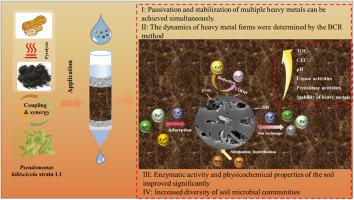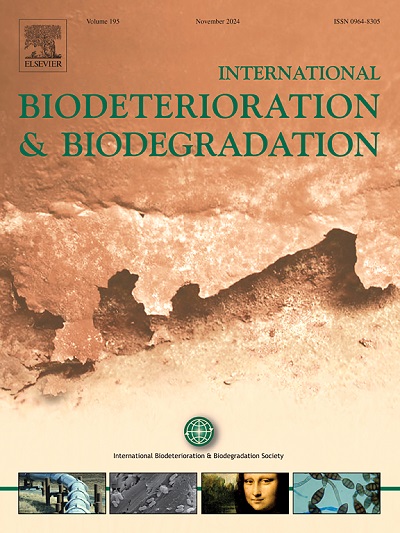Synergistic remediation of electroplating wastewater contaminated soil and reduction of risk of groundwater contamination by biochar and Pseudomonas hibiscicola strain L1
IF 4.1
2区 环境科学与生态学
Q2 BIOTECHNOLOGY & APPLIED MICROBIOLOGY
International Biodeterioration & Biodegradation
Pub Date : 2024-09-26
DOI:10.1016/j.ibiod.2024.105926
引用次数: 0
Abstract
With the continuous development of electroplating industry, a large amount of electroplating wastewater is generated, which can be harmful to soil and basement. Introducing microorganisms into polluted soil can improve the soil environment, but it has the disadvantages of easy loss and low activity. In this study, the synergistic effect of biochar and strain L1 (BL1) was utilized to effectively reduce the risk of groundwater contamination by Ni(II), Cu(II), Cr(VI), and Zn(II), which are common heavy metals in electroplating wastewater. And the mechanism was found as BL1 was found to increase the porosity and water retention of the soil by specific surface area determination (BET) and scanning electron microscopy (SEM), favored the growth of soil microorganisms. It was found that BL1 could improve soil pH, enzyme activity, total organic carbon and other indicators by measuring soil physical and chemical properties. The results of microbial community analysis showed that BL1 increased the diversity of soil community and enriched microorganisms with nitrification and denitrification functions, thus promoting the removal of NH4+-N and NO3-N. Fourier transform infrared spectroscopy (FTIR) and X-ray diffraction (XRD) diffraction results showed that -OH, -CH, C=O, Si-O-Si, CO32− and PO43− of BL1 complexed with heavy metals to form precipitates. Thus, the conversion of heavy metals to the stable state was promoted. These results show that the addition of BL1 can effectively improve the soil environment and promote the self-recovery of soil function.

生物炭和木槿假单胞菌菌株 L1 协同修复电镀废水污染土壤并降低地下水污染风险
随着电镀工业的不断发展,产生了大量的电镀废水,这些废水会对土壤和地下室造成危害。在污染土壤中引入微生物可以改善土壤环境,但存在易流失、活性低等缺点。本研究利用生物炭和菌株 L1(BL1)的协同效应,有效降低了电镀废水中常见重金属 Ni(II)、Cu(II)、Cr(VI)和 Zn(II) 污染地下水的风险。通过比表面积测定(BET)和扫描电子显微镜(SEM)发现,BL1 能增加土壤的孔隙度和保水性,有利于土壤微生物的生长。通过测定土壤理化性质发现,BL1 可以改善土壤 pH 值、酶活性、总有机碳等指标。微生物群落分析结果表明,BL1 增加了土壤群落的多样性,丰富了具有硝化和反硝化功能的微生物,从而促进了 NH4+-N 和 NO3-N 的去除。傅立叶变换红外光谱(FTIR)和 X 射线衍射(XRD)结果表明,BL1 的 -OH、-CH、C=O、Si-O-Si、CO32- 和 PO43-与重金属络合形成沉淀。因此,促进了重金属向稳定状态的转化。这些结果表明,添加 BL1 可以有效改善土壤环境,促进土壤功能的自我恢复。
本文章由计算机程序翻译,如有差异,请以英文原文为准。
求助全文
约1分钟内获得全文
求助全文
来源期刊
CiteScore
9.60
自引率
10.40%
发文量
107
审稿时长
21 days
期刊介绍:
International Biodeterioration and Biodegradation publishes original research papers and reviews on the biological causes of deterioration or degradation.

 求助内容:
求助内容: 应助结果提醒方式:
应助结果提醒方式:


